How Speech Therapy Helps Individuals Recover Communication Skills
Reclaiming Voice and Connection: The Impact of Speech Therapy on Communication Recovery

Understanding the Power of Speech Therapy in Restoring Communication
Speech therapy is a vital healthcare service dedicated to helping individuals of all ages recover, improve, and maintain their communication, language, and swallowing skills. Whether addressing developmental delays, neurological injuries, or age-related challenges, speech therapy uses personalized, evidence-based approaches to facilitate meaningful progress. This article explores how speech therapy aids in recovery, the techniques employed, benefits across conditions, and its crucial role in promoting confidence, independence, and social engagement.
Tailored Interventions for Effective Communication Rehabilitation
How does speech therapy aid in the recovery and enhancement of communication skills?
Speech therapy plays a vital role in helping individuals recover and improve their communication abilities. It does so by offering personalized interventions that target specific speech or language challenges. Under the guidance of a speech-language pathologist (SLP), patients participate in exercises designed to strengthen their speech muscles, enhance language comprehension, and improve fluency.
Typical activities in therapy include practicing pronunciation, engaging in reading aloud, and performing oral motor exercises that build mouth and tongue coordination. Social skills training through role-playing and conversation practice further boosts confidence and functional communication. The use of speech exercises and strategies tailored to each person's needs ensures that progress is both meaningful and lasting.
By focusing on these targeted techniques, speech therapy encourages clearer speech, better understanding of spoken and written language, and increased confidence in social interactions. This personalized approach not only helps individuals regain lost skills but also elevates their overall quality of life through more effective communication. Consistent effort and practice are essential components that lead to notable improvements in both expressive and receptive language skills, making speech therapy a powerful tool for communication recovery.
Techniques and Methods in Speech Therapy
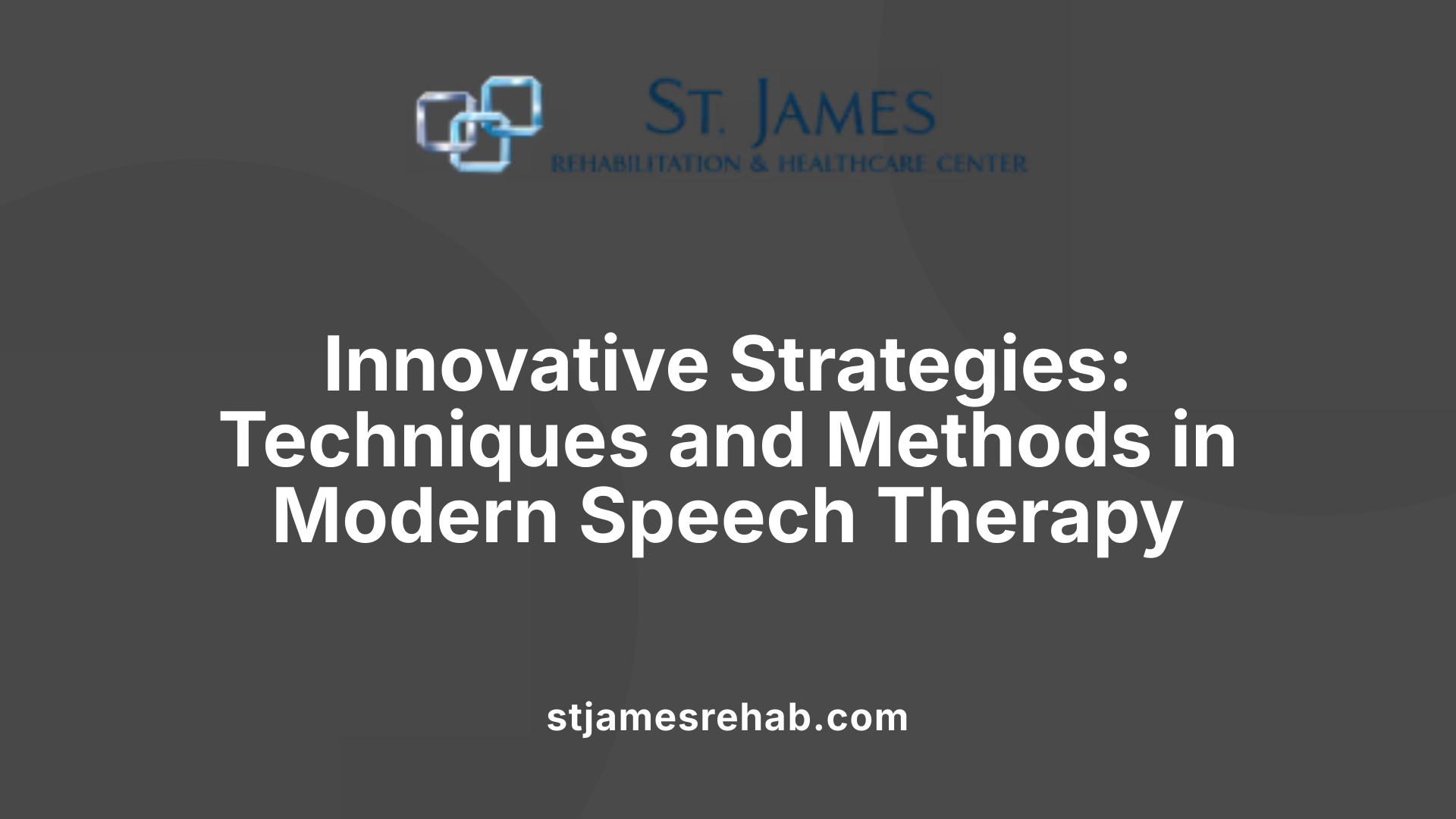
What techniques and methods are used in speech therapy to improve communication?
Speech therapy employs a wide array of approaches specifically tailored to each individual's needs. These techniques are designed to enhance different aspects of communication, including speech clarity, language comprehension, and social interaction.
One common set of methods involves articulation exercises. These activities focus on the correct production of sounds, helping individuals pronounce words more clearly. Speech-motor practice, which includes exercises to strengthen the muscles in the face, mouth, and throat, is also vital. These exercises improve skills needed for both speech and safe swallowing.
Language intervention forms another cornerstone of therapy. This includes activities like expanding vocabulary, constructing sentences, and understanding complex language structures. The use of visual aids such as pictures, charts, or written materials helps reinforce learning and comprehension.
In addition to traditional exercises, therapists incorporate assistive devices and sensory cues. Sign language, communication boards, speech-generating devices, and electronic aids support individuals with severe speech or language impairments, helping them communicate more effectively.
Therapists often employ behavioral techniques such as modeling, where they demonstrate correct speech patterns, and positive reinforcement, which encourages continued practice and improvement. Strategies like giving choices, self-talk, and parallel talk are used to promote active participation and social interaction.
Furthermore, methods like simplifying sentences, slow speech pacing, and cueing are used to improve fluency and reduce speech disruptions such as stuttering or apraxia.
Music, rhythm, and sensory stimulation are also integrated into therapy sessions to enhance engagement and facilitate speech learning. Visual cues, tactile prompts, and auditory feedback are important tools for sensory integration.
Overall, speech therapy combines evidence-based techniques—including drills, play activities, and sensory cues—with personalized plans. This integrated approach effectively addresses a range of disorders such as aphasia, apraxia, stuttering, voice disorders, and swallowing issues, aiming to improve communication skills and confidence.
Benefits for People with Speech and Language Disorders
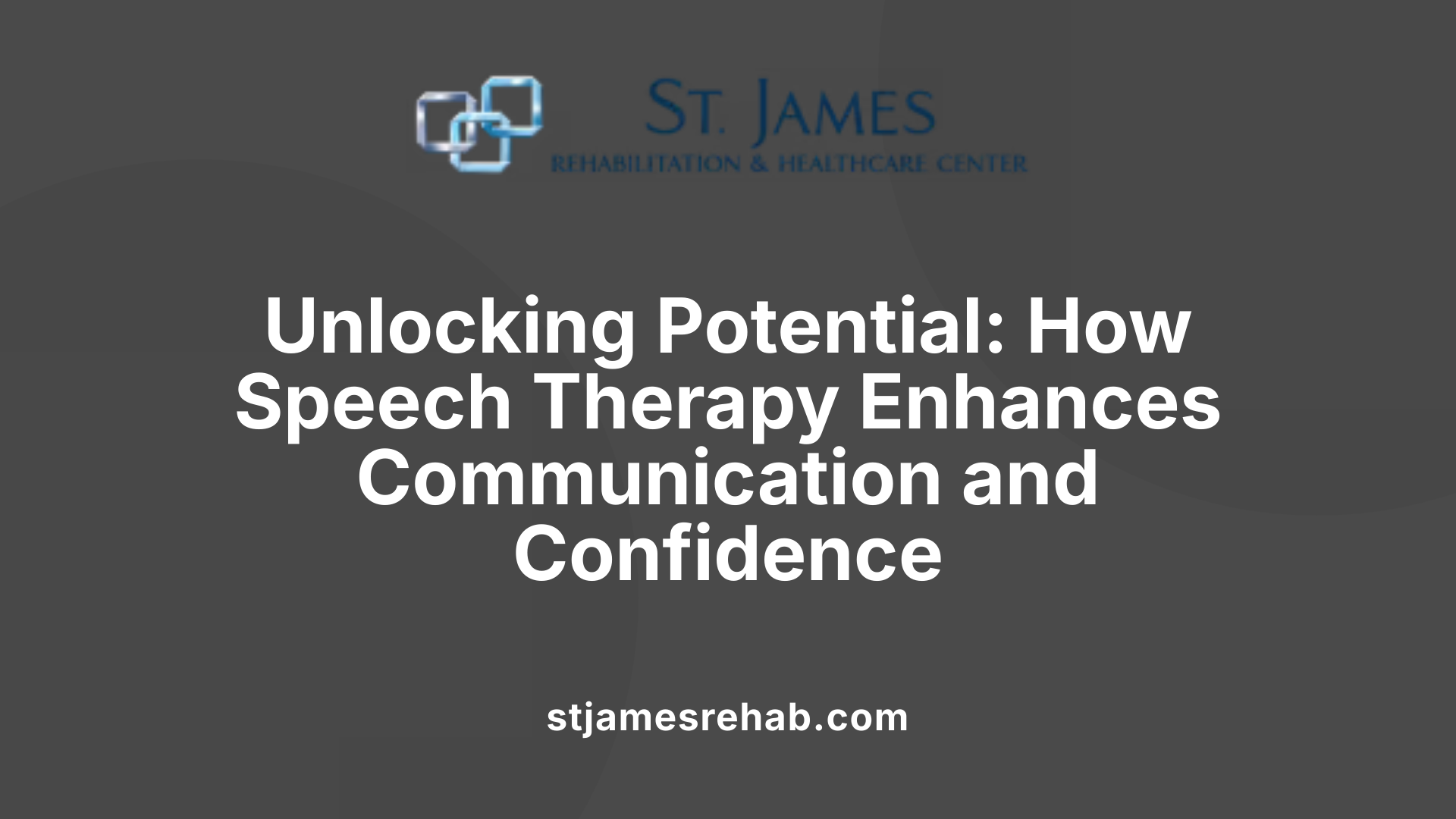
What are the benefits of speech therapy for individuals with speech or language disorders?
Speech therapy provides significant advantages for those experiencing difficulties with communication. It enhances pronunciation, fluency, comprehension, and articulation, allowing individuals to express their thoughts with greater clarity and understand others more effectively.
Through tailored exercises and techniques, speech therapy helps improve the accuracy of speech sounds, increase speech rate, and develop stronger language skills. This often results in better social interactions, as individuals can participate more confidently in conversations and daily activities.
In addition to improving speech and language capabilities, therapy also fosters a boost in self-esteem and confidence. When individuals see progress, they feel more comfortable engaging with others, which promotes social inclusion and independence.
People with conditions such as aphasia, apraxia, dysarthria, and articulation disorders can experience notable recovery. For example, they learn strategies to regain lost speech abilities, allowing better participation in work, education, and community life.
Early intervention is particularly effective, especially in children, as it supports academic success and emotional development. Consistent practice and the support of qualified speech-language pathologists help maximize these benefits.
Overall, speech therapy empowers individuals by improving communication skills, which directly enhances their overall quality of life, emotional well-being, and social participation.
Rehabilitation After Neurological Events
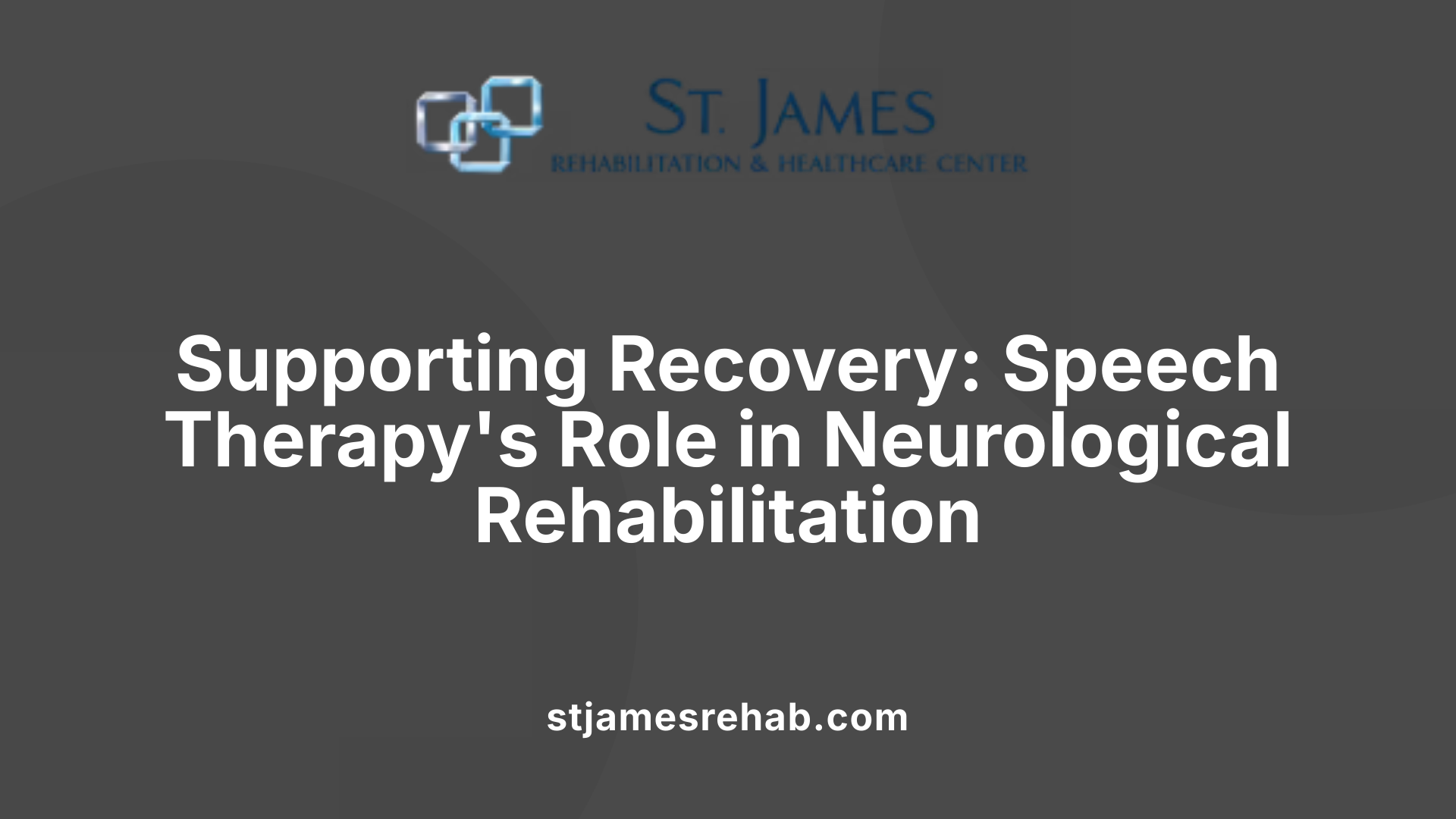
How does speech therapy contribute to recovering communicative abilities after neurological conditions like stroke or brain injury?
Speech therapy plays a crucial role in helping individuals regain their communication skills following neurological events such as strokes, traumatic brain injuries, or neurodegenerative diseases. The therapy employs targeted exercises and strategies designed to promote neuroplasticity, the brain's ability to rewire and adapt.
Therapists provide personalized interventions to address specific deficits like aphasia, dysarthria, or apraxia. These interventions often include speech drills that strengthen muscle coordination and language tasks that rebuild vocabulary and sentence structure. Additionally, non-verbal communication strategies—such as gestures, facial expressions, and picture-based communication—are also taught to support effective interaction.
The use of assistive technology, like speech-generating devices and communication boards, further enhances recovery, especially in severe cases. Early treatment is vital because the brain’s capacity to recover is greater soon after the injury. Engaging family members in therapy through training and exercises creates a supportive environment that fosters ongoing progress.
Various techniques, including speech drills, singing therapy, and alternative methods, can expedite recovery even when speech is heavily impaired. These approaches help improve not only speech and language but also cognitive functions and swallowing abilities.
Overall, speech therapy significantly contributes to restoring communication, supporting independence, and improving overall quality of life for individuals recovering from neurological conditions. It underlines the importance of a multidisciplinary approach where therapy, technology, and family involvement come together to achieve the best outcomes.
| Technique | Purpose | Additional Details |
|---|---|---|
| Speech drills | Strengthen articulation and muscle coordination | Repetitive exercises targeting specific sounds |
| Non-verbal strategies | Use of gestures and facial cues | Enhances communication when speech is limited |
| Assistive technology | Tools like speech devices or communication apps | Provide alternative means to express thoughts |
| Singing therapy | Use of music to facilitate speech and language recovery | Engages different brain areas to promote speech |
| Cognitive-linguistic tasks | Improve memory, attention, and language processing | Facilitates overall cognitive and communication skills |
This comprehensive approach underscores how speech therapy adapts to each individual’s needs, making recovery from neurological events more effective and meaningful.
Target Skills in Speech Therapy
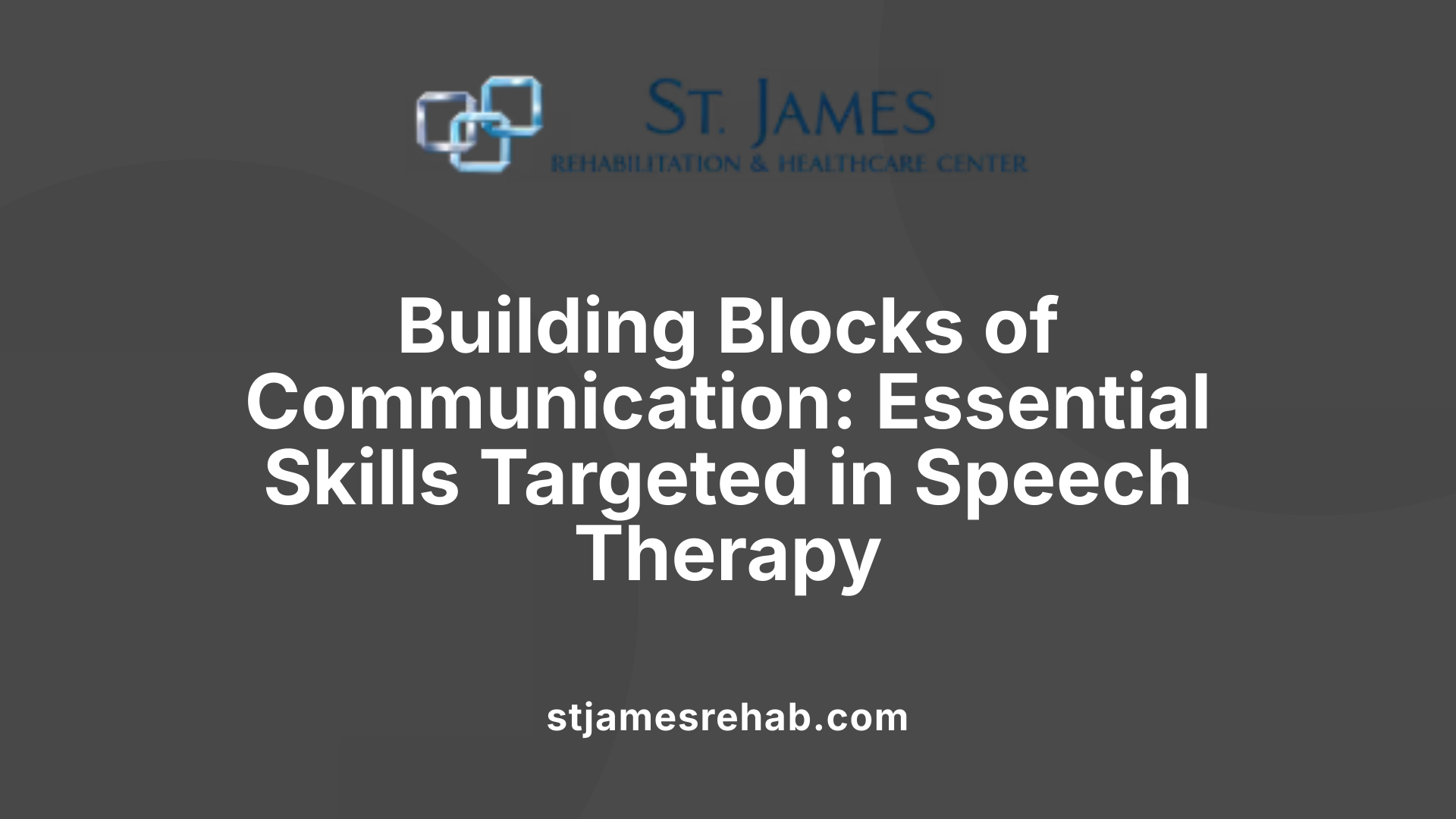
What skills and areas are targeted in speech therapy?
Speech therapy aims to improve a broad spectrum of communication and language skills, tailored to each individual’s needs. Its primary focus includes enhancing speech production, articulation, and phonological awareness, which are essential for clear and effective spoken communication.
In addition, speech therapy works on language understanding and usage, covering both expressive language (ways we convey thoughts) and receptive language (how we comprehend spoken and written words). For literacy, therapists often target reading comprehension, spelling, and early reading skills, especially in children developing foundational literacy.
Social communication is another crucial area, involving pragmatic language skills such as turn-taking, interpreting social cues, using appropriate gestures, and managing conversational exchanges. This supports better interactions in daily life and helps build social confidence.
Specific areas addressed can include voice quality, resonance, and pitch control to improve vocal clarity and expression. Additionally, therapy often targets pragmatic language skills, which are vital for social interactions, and cognitive-communicative skills, which involve memory, attention, problem-solving, and planning within communication contexts.
Interventions are customized to each person’s goals, which follow the SMART criteria—specific, measurable, achievable, relevant, and time-bound. Goals are aligned with the individual’s age, background, and particular challenges, ensuring practical and functional improvements.
From preschool children working on phonological awareness and early vocabulary to adults focusing on speech clarity after stroke, speech therapy covers a comprehensive array of skills. These include speech sound production, language comprehension, literacy, voice modulation, and social communication strategies.
Incorporating augmentative and alternative communication (AAC) tools like communication boards or speech-generating devices, therapy also supports individuals with severe speech or language impairments.
Overall, the targeted areas in speech therapy span from basic speech sounds to complex social and cognitive skills, enabling individuals to communicate more effectively across all aspects of life.
Role of Speech-Language Pathologists and Therapy Approaches

Who can assist in improving communication skills for those with speech or language disorders?
Speech-language pathologists (SLPs), also known as speech therapists, are the professionals specially trained to help individuals with communication challenges. They assess, diagnose, and treat a wide range of speech, language, voice, fluency, and swallowing disorders.
SLPs work with people of all ages—children struggling with developmental delays, adults recovering from strokes or neurological conditions, and seniors facing age-related communication issues. They operate in various environments such as schools, hospitals, clinics, and private practices.
An essential part of their role is developing personalized therapy plans tailored to each person’s specific needs. This customization ensures targeted intervention, whether it involves articulation exercises, language stimulation activities, or the use of assistive communication devices.
They often collaborate with other healthcare providers, teachers, and families to create a comprehensive support system that promotes effective communication.
Why are tailored treatment plans important?
Every individual’s communication challenges are unique. Therefore, a one-size-fits-all approach is ineffective.
SLPs use detailed assessments to understand the severity, nature, and context of each person's difficulties. Based on this, they devise strategies and activities—like speech exercises, social skills training, or cognitive-communication therapies—that address specific problems.
Personalized plans not only enhance the effectiveness of therapy but also motivate individuals by showing clear progress aligned with their goals and daily experiences.
Group versus individual therapy: Which is better?
Both group and individual therapies have their advantages, and the choice depends on the individual’s needs and preferences.
- Individual therapy provides focused, one-on-one attention. It allows the therapist to customize activities closely, track progress more precisely, and address sensitive issues privately.
- Group therapy encourages social interaction, which is especially beneficial for practicing real-life communication skills such as turn-taking, listening, and conversational engagement.
Often, therapists combine both approaches to maximize benefits. For example, a child might start with individual sessions to build foundational skills and later join group activities to enhance social communication.
In conclusion, speech therapists play a vital role in helping people overcome communication barriers. Their ability to tailor interventions and choose suitable therapy settings significantly impacts recovery outcomes and overall confidence in communication.
The Importance of Personalized and Combined Therapy Approaches
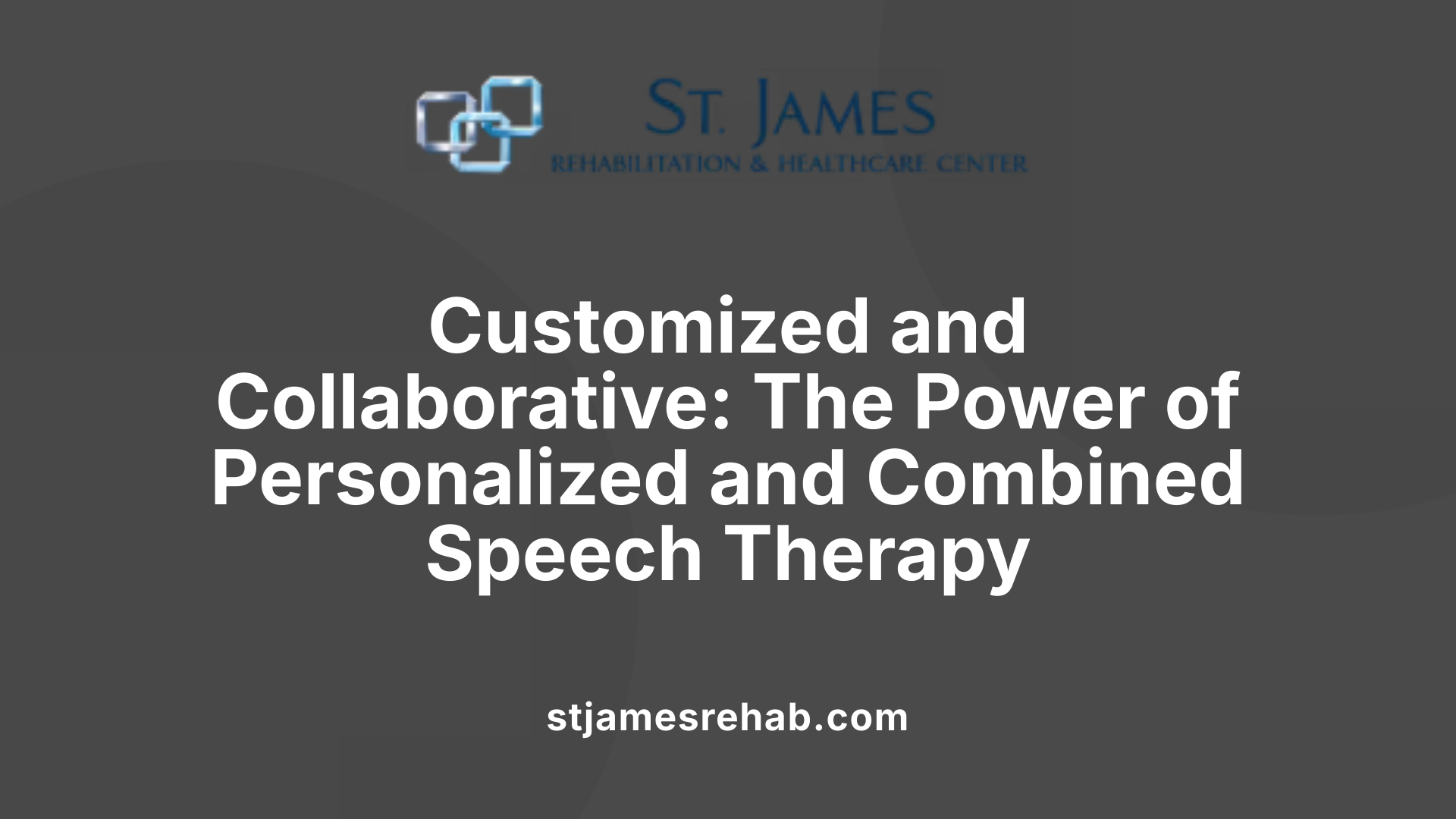
Why is personalized treatment crucial in speech therapy?
Each individual has unique communication challenges, whether they are children with speech delays or adults recovering from neurological injuries. Personalized therapy plans are designed after thorough assessments by speech-language pathologists (SLPs), ensuring specific areas like articulation, language comprehension, or swallowing are targeted effectively.
Tailored programs adapt exercises and techniques to fit individual needs, enhancing progress and confidence. For example, a child with expressive language difficulties might focus on vocabulary expansion and storytelling, while an adult with aphasia may work on word retrieval and conversational skills.
How do individual and group therapy benefits compare?
Individual therapy is highly valued because it provides focused, one-on-one attention. This allows SLPs to closely monitor progress, customize activities precisely, and modify strategies in real-time. It is often preferred for severe or complex speech and language disorders that require intensive intervention.
In contrast, group therapy fosters social communication skills by encouraging interaction with peers. It helps participants practice conversational turn-taking, listening skills, and social cues in a less restrictive environment. For children, this can also boost confidence and motivation, especially when learning alongside friends.
Why is combining therapy approaches often advantageous?
Recent studies show that both individual and group therapies can significantly improve communication skills. Combining these methods optimizes outcomes by providing personalized attention while also enhancing social interaction.
A mixed approach allows patients to receive targeted exercises on specific issues in individual sessions and then generalize these skills in social settings through group activities.
The role of family involvement in therapy
Involving family members in therapy sessions and at-home practice is crucial. Family participation reinforces strategies learned during therapy, creates a supportive environment, and accelerates progress.
For children, parental involvement can include practicing speech exercises, engaging in conversation-rich activities, and providing encouragement. For adults, family members can assist with cognitive exercises or assistive technology use.
Implementing tailored programs that incorporate both individual and group therapies, with active family participation, ensures a comprehensive and effective approach to improving communication skills.
Empowering Speech Recovery for a Better Life
Speech therapy is a powerful tool that restores and enhances communication abilities, necessary for personal, social, and professional well-being. Through personalized strategies, innovative techniques, and collaborative efforts, individuals overcoming speech and language challenges can regain confidence, independence, and meaningful social engagement. Early intervention, continuous practice, and the support of skilled speech-language pathologists are key to unlocking their full communicative potential. As advancements in therapy methods and assistive technologies continue, the future promises even greater success in helping people overcome communication barriers and improve their overall quality of life.
References
- Speech Therapy: What It Is & How It Works
- Unlocking Communication: The Importance of Speech Therapy
- The Power of Speech Pathology in Improving Communication
- How Speech Therapy Improves Communication Skills
- How Speech Therapy Can Restore Communication Skills After a ...
- How Speech Therapy Can Help with Conversational Skills
- Speech therapy: a crucial part of recovery - Good Samaritan Society
- The Importance of Speech Therapy for Mental Health
- Exploring benefits of speech and language therapy interventions for ...
- How Speech Therapy Can Improve Communication Skills





